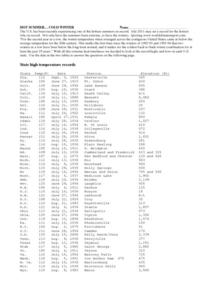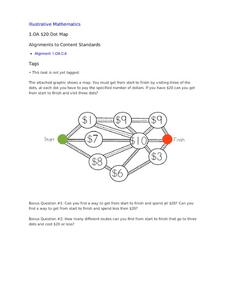Curated OER
Addition Word Problems #2
Expose scholars to the ways addition is constantly used through 15 word problems. Many of these have more than two addends, and several involve money math and adding numbers with decimals to the hundredths place. Learners also must use...
DK Publishing
Draw the Shape ~ Counting Rectangles
It's all about rectangles here, and young geometers begin by following a dotted outline to trace the shape, then print one of their own. Next, they examine three pictures to count the rectangles in each. Learners practice writing...
Curated OER
Learning 1 - Write the Word
Let's start from the beginning! Young counters complete activities focused on the number one to solidify their understanding of its value. First, they trace its word form and then try it on their own (maybe more than once, even). Next,...
Curated OER
Line of Symmetry
Where is the line of symmetry in these shapes? Review this concept using the visual guide at the top of the page, explaining how some shapes have multiples lines. Consider demonstrating this concept with large cut-outs, physically...
Curated OER
Recognizing Multiples
By asking learners to identify multiples of 6, 7, and 8, you will be able to assess their grasp of these multiplication facts. For each of these numbers learners examine five set of digits and circle the multiples from the sets. A final...
DK Publishing
Sneaky Snakes: Missing Numbers
These sneaky snakes can help your kindergartners learn number sequence. Each snake has a number sequence up to 10 between their stripes, and kids write the numbers that are missing from the sequence. Some of the snakes begin at numbers...
Alabama Learning Exchange
Sky High
How are skyscrapers built? What does it take to make a structurally sound building? How can one work within a budget to complete a building project? These guiding questions will be investigated and answered within a hands-on lesson....
Illustrative Mathematics
Toll Bridge Puzzle
Here is a great problem-solving activity for young mathematicians. Intended solely for instructional purposes, the activity is appropriate for learners to add four numbers together. Not only must they add four numbers together,...
Illustrative Mathematics
Converting Fractions of a Unit into a Smaller Unit
There is more than one way to answer a question; especially when you have fractions in measurement. Here are three questions with real-world situations in which 5th graders are asked to provide answers in three ways: a larger unit of...
Curated OER
The Value of Education
The real value of education is highlighted in more than one way on a worksheet designed to not only add, subtract, multiply, and divide decimals to hundredths, but also to address the correlation between higher pay with accomplishing...
Curated OER
How many movies can you see in one day?
For kids who love movies, figuring out a schedule for the maximum number that can be seen in one day is not only a good demonstration of Common Core mathematical practices, but also a highly motivating activity. Robert Kaplinsky...
Yummy Math
Hot Summer. . . Cold Winter
A table of each state's record temperature reports data that middle schoolers can place on a number line for analysis. A written explanation of how to use this tool and the concept of absolute value are also included. Nine questions are...
Illustrative Mathematics
How Many _______ Are In. . . ?
Help your learners gain meaningful understanding of dividing fractions using fraction models. The activity includes nine problems which are sequenced to show how the fraction division algorithm evolves. Have students use graph paper or...
Curated OER
Making a Ten
An addition table supports third graders as they learn strategies to improve their math fluency. When finding sums greater than ten, learners are taught how to first make a ten and then add on the rest. A similar method is also...
Curated OER
Birds' Eggs
More than just data, scatter plots are full of information that can be used to answer a variety of questions. This lesson uses a plot with information about bird egg sizes to answer questions about the relationship between length and...
Center for Innovation in Education
Unifix Cubes
Support young mathematicians with building a strong foundational number-sense using this series of printable Unifix® cube strips. Adaptable to the teaching of a variety of different concepts, from basic counting and cardinality, to...
Illustrative Mathematics
$20 Dot Map
Challenge the addition skills of young learners with this open-ended math problem. The task is simple, get from start to finish by connecting a series of three numbers. The trick is that the sum of the numbers must be less than or equal...
Kentucky Department of Education
Multi-Digit Multiplication Strategies
There is more than one way to solve a multiplication problem, and many learners find that the lattice multiplication method can be a helpful one. Fourth graders take an initial formative assessment before working in groups of two or...
Illustrative Mathematics
Regular Tessellations of the Plane
Bringing together the young artists and the young organizers in your class, this lesson takes that popular topic of tessellations and gives it algebraic roots. After covering a few basic properties and definitions, learners attack the...
Benjamin Franklin High School
Saxon Math: Algebra 2 (Section 3)
In this third of a twelve-part series, the focus moves from using matrices to solving systems of equations with substitution and elimination, including more than two dimensions and variables in equations, and analyzing statistical data....
Fredonia State University of New York
Watch Your Step…You May Collide!
Can two lines intersect at more than one point? Using yarn, create two lines on the floor of the classroom to find out. Cooperative groups work through the process of solving systems of equations using task cards and three different...
EngageNY
Interpreting the Standard Deviation
Does standard deviation work for non-symmetrical distributions, and what does it mean? Through the use of examples, high schoolers determine the standard deviation of a variety of distributions and interpret its meaning. Problems require...
Illustrative Mathematics
Solving Two Equations in Two Unknowns
More than just a one-problem resource, learners must explain their answer and incorporate a writing component to mathematical thinking. The resource also includes an explanation of the solution to help with the reasoning.
Charleston School District
Transformation Basics
Transformations are more than the process in which sports cars become fighting robots. Listed in terms of which transformations give congruent or similar figures, several resources provide definitions and examples of the four basic...

























